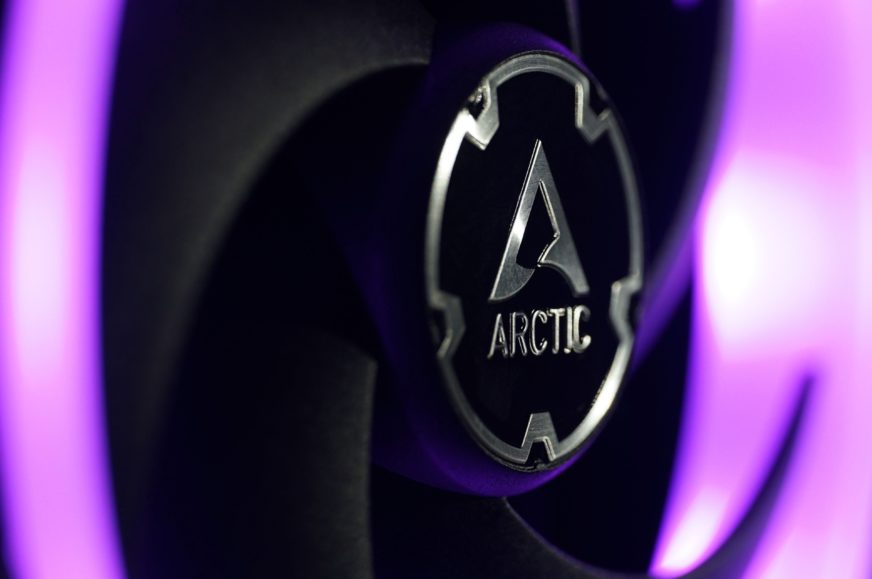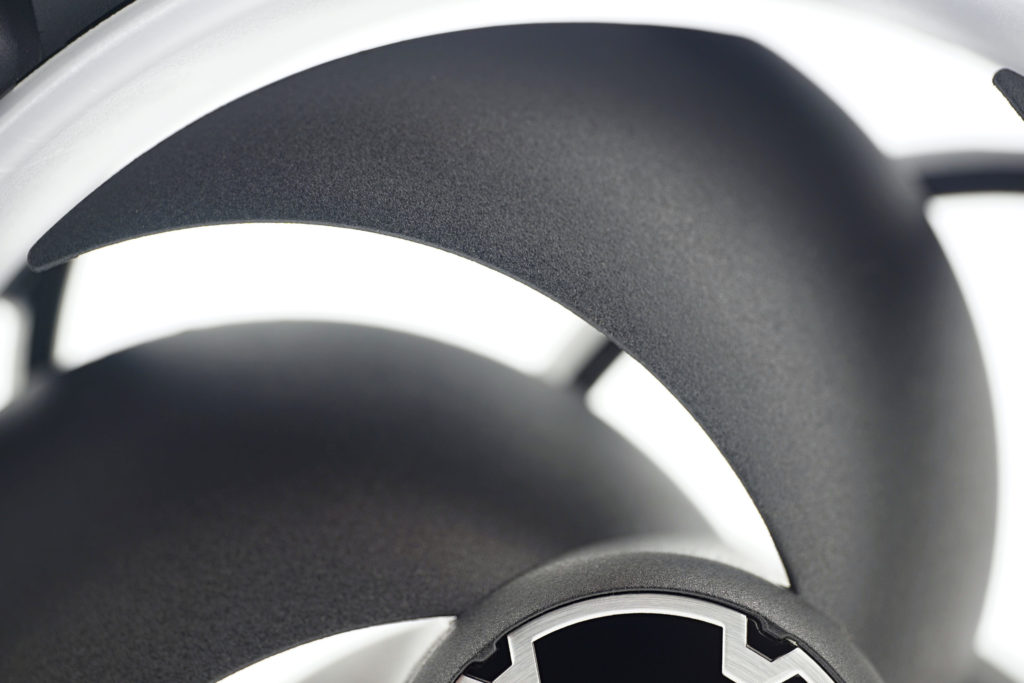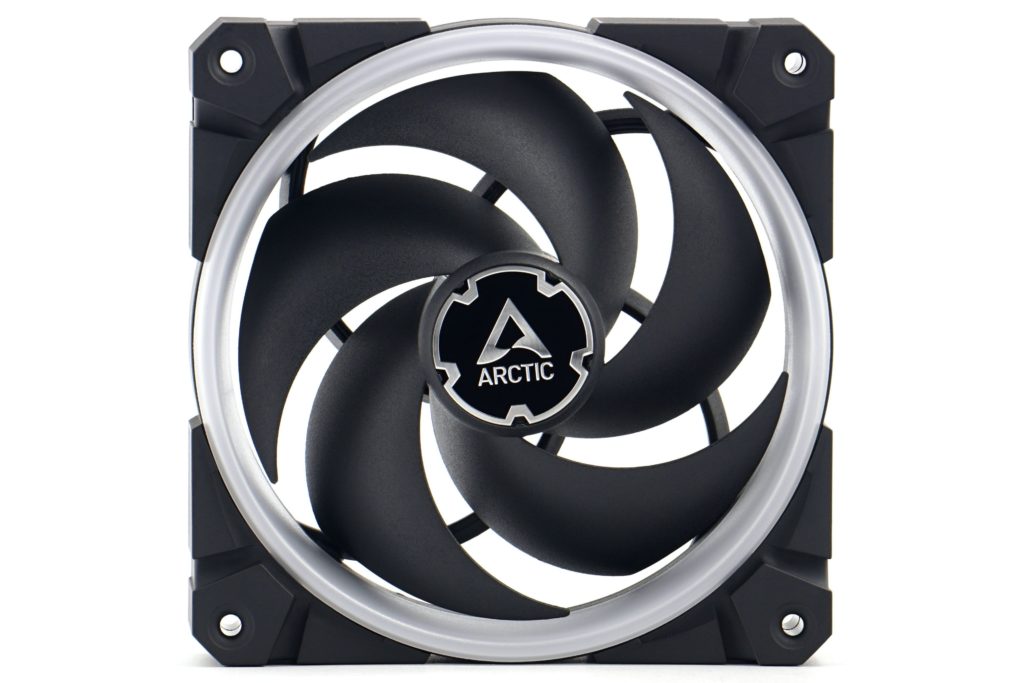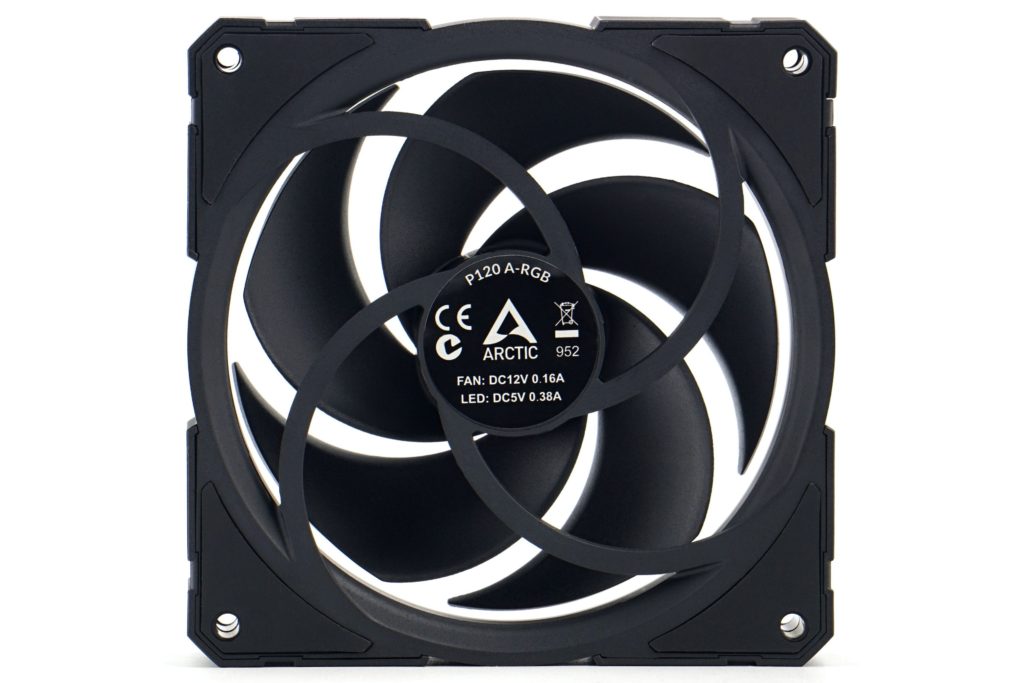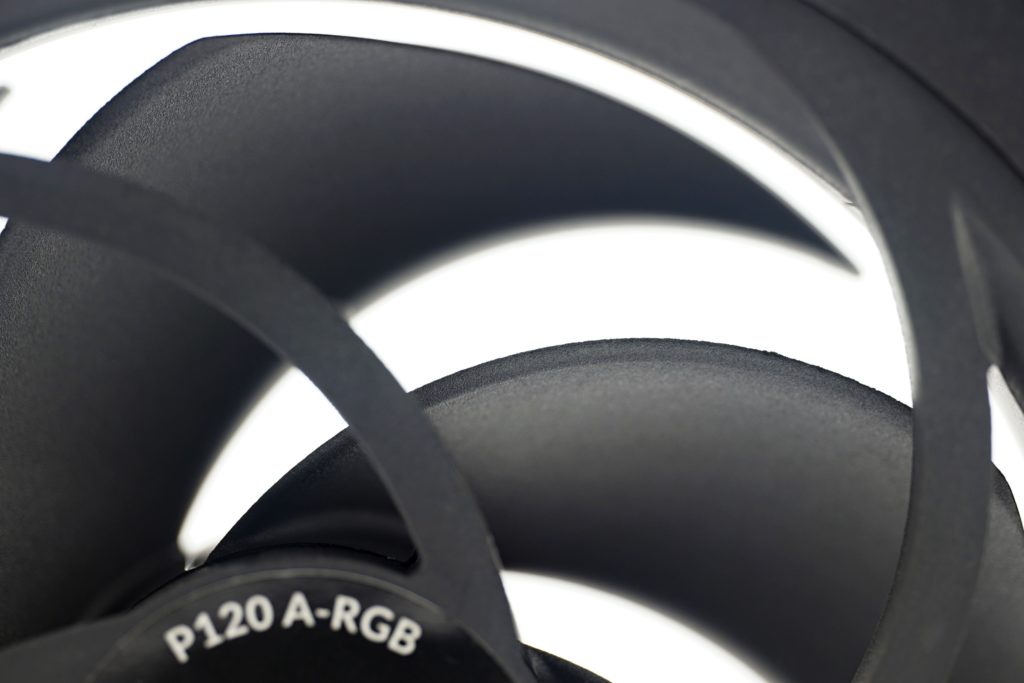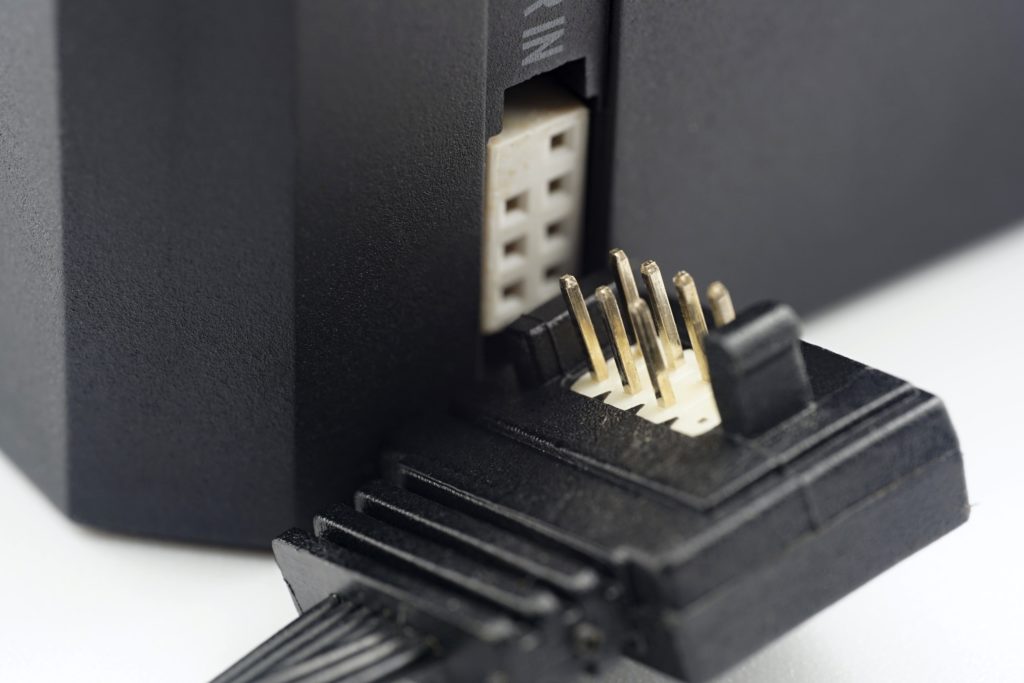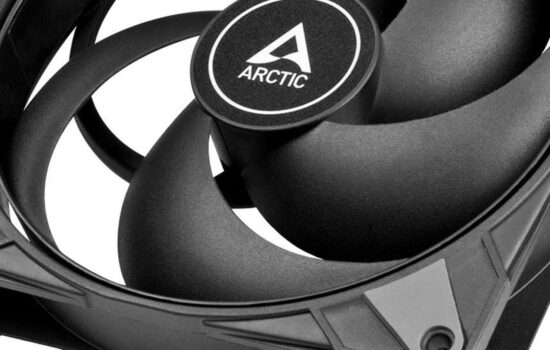Arctic BioniX P120 A-RGB in detail
Now that’s what we call a turnaround. Remember how the BioniX F120 failed on obstacles? The newer BioniX P120 (A-RGB) no longer has such a fundamental limitation. On the contrary, it is significantly less stifled by obstacles than many competing fans. Just tame those vibrations, fine-tune the acoustics, where there are some flaws, and it’ll be great. The basis (the rotor) is better in practice than the label parameters suggest.
It’s not often that we give a piece of hardware a negative “Stay Away” award, but it fits the BioniX F120 well. Arctic itself knows that it is not a very amazing fan. Although subtly and indirectly, it announces it publicly. The biggest design change between the Freezer 33 and 34 lies in the fan used. While the “eSport” Freezer 33’s fins still have BioniX F120 on them (and the F12 fan on the standard Freezer 33 has the same rotor shape), the Freezer 34 now uses BioniX P120, and the heatsink design is very similar.
| Brand and model of fan | Paper specicifations * | Price [EUR] | ||||||||
| Format (and thickness) in mm | Connecting | Speed [rpm] | Airflow [m3/h] | Static pressure [mm H2O] | Noise level [dBA] | Bearings | MTBF [h] | |||
| Motor | RGB LED | |||||||||
| Arctic BioniX P120 A-RGB | 120 (30) | 4-pin (PWM) | 3-pin (5 V) | 400–2300 | 81.55 | 2.10 | 33.4 | fluid | N/A | 21 |
| Akasa OTTO SF12 | 120 (25) | 4-pin (PWM) | N/A | 0–2000 | 164.84 | 3.59 | 7.1–31.7 | ball | 80 000 | 22 |
| Cooler Master SickleFlow 120 ARGB | 120 (25) | 4-pin (PWM) | 3-pin (5 V) | 680–1800 | 105.34 | 2.50 | 8.0–27.0 | rifle | 160 000 | 15 |
| Alphacool SL-15 PWM | 120 (15) | 4-pin (PWM) | N/A | 600–1800 | 71.40 | 1.20 | 32.0 | ball | 50 000 | 11 |
| Arctic BioniX F120 | 120 (25) | 4-pin (PWM) | N/A | 200–1800 | 117.00 | 2.10 | 20.0 | fluid | N/A | 10 |
| SilverStone SST-AP123 | 120 (25) | 3-pin (DC) | N/A | 1500 | 96.84 | 1.46 | 23.8 | fluid | 50 000 | 25 |
| Noctua NF-P12 redux-1700 PWM | 120 (25) | 4-pin (PWM) | N/A | 400–1700 | 120.20 | 2.83 | 25.1 | SSO | 150 000 | 13 |
| SilentiumPC Fluctus 120 PWM | 120 (25) | 4-pin (PWM) | N/A | 300–1800 | N/A | N/A | N/A | fluid | 100 000 | 12 |
| MSI MEG Silent Gale P12 | 120 (25) | 4-pin (PWM) | N/A | 0–2000 | 95.48 | 2.21 | 22.7 | hydrodynamic | 50 000 | 31 |
| Asus ROG Strix XF120 | 120 (25) | 4-pin (PWM) | N/A | 1800 | 106.19 | 3.07 | 22.5 | „MagLev“ | 400 000 | 23 |
| Akasa Vegas X7 | 120 (25) | 4-pin (PWM) | 4-pin (12 V) | 1200 | 71.19 | N/A | 23.2 | fluid | 40 000 | 11 |
| Reeven Coldwing 12 | 120 (25) | 4-pin (PWM) | N/A | 300–1500 | 37.54–112.64 | 0.17–1.65 | 6.5–30.4 | sleeve | 30 000 | 12 |
| Reeven Kiran | 120 (25) | 4-pin (PWM) | shared | 400–1500 | 110.10 | 2.95 | 33.6 | fluid | 120 000 | 17 |
| SilentiumPC Sigma Pro 120 PWM | 120 (25) | 4-pin (PWM) | N/A | 500–1600 | 79.00 | N/A | 15.0 | hydraulic | 50 000 | 7 |
| SilentiumPC Sigma Pro Corona RGB 120 | 120 (25) | 4-pin (PWM) | 4-pin (12 V) | 1500 | 56.58 | N/A | N/A | hydraulic | 50 000 | 12 |
| SilverStone SST-AP121 | 120 (25) | 3-pin (DC) | N/A | 1500 | 60.08 | 1.71 | 22.4 | fluid | 50 000 | 18 |
| SilverStone SST-FQ121 | 120 (25) | 7-pin (PWM) | N/A | 1000–1800 | 114.68 | 0.54–1.82 | 16.4–24.0 | PCF (fluid) | 150 000 | 20 |
| Xigmatek XLF-F1256 | 120 (25) | 3-pin (DC) | N/A | 1500 | 103.64 | N/A | 20.0 | „long-life“ | 50 000 | 16 |
* When reading performance values, a certain amount of tolerance must always be taken into account. For maximum speeds, ±10 % is usually quoted, minimum speeds can vary considerably more from piece to piece, sometimes manufacturers will overlap by as much as ±50 %. This must then also be adequately taken into account for air flow, static pressure and noise levels. If only one value is given in a table entry, this means that it always refers to the situation at maximum speed, which is achieved at 12 V or 100 % PWM intensity. The manufacturer does not disclose the lower limit of the performance specifications in its materials in that case. The price in the last column is always approximate.
The BioniX P120 (A-RGB) has four fewer blades than the BioniX F120, only five. However, the surface area per blade is at least twice as large and the difference is also in their sharper angle. The blades are long, distinctly curved, and also feature a above-standard thickness. At their widest point they are up to 3.2 mm, on the Bionix F120 only 2.0 mm.
The thicker material has the advantage that it is not subject to deformation during “flight” and has a lower thermal expansion. This also applies to the non-illuminated variant (BioniX P120 without A-RGB in the name), which has blades made of the same material. In the case of these fans, the design of the rotor does not differ because the illuminated element is within the frame – the inner hoop.
The light-conducting part extends from the front to about half the thickness of the fan. So you can’t see it from both sides. In total, twelve LEDs are used and the light diffusion is at an average level. This means that you can immediately locate the light sources (the spots underneath the LEDs), but it’s no eyesore. It would probably be unfair to write about the non-uniform backlighting of the frame (it always is to some extent with these designs), but there are also “RGB” fans with more even light diffusion within a ring lightguide.
Particularly for those selecting a fan for a liquid cooler radiator, it is important to note the extra thickness. While the rotor doesn’t exceed standard 25 mm fans in thickness, its frame does. The overall thickness is 30 mm, which means that regular screws will have short threads and you’ll need 35 mm ones, 5 mm longer than the “normal” ones. The greater thickness here is both for the lightguide, which protrudes more prominently in front of the rotor, but also for the thicker frame struts. Overall, this is a sturdy fan weighing up to 223g. That’s almost twice the weight of the SilentiumPC Sigma Pro 120 PWM.
The fan design is therefore sturdy, solid, but the anti-vibration pads are thin (0.8 mm). We wouldn’t have picked up on this if one of the biggest negatives of this fan wasn’t the more intense vibrations. These would be greatly reduced by the thicker soft pads. We mentioned above that the blades are thick. However, it’s worth adding to this that both the leading and trailing edges have a narrow, aerodynamic tip, as you can see clearly in the detail in the photo.
What’s unusual about the BioniX P120 A-RGB is the connectivity. Specifically, that it has essentially modular cabling. You have to connect the cable to the fan and you even have a choice. In fact, there are several cables in the accessories, for connecting the motor and the A-RGB LED. This always to a proprietary 9-pin connector on the fan. You connect one and the other to it at the same time (so it’s not like you don’t have to connect a lighting cable, for example), but there’s a different cable to the motherboard than there is to the Arctic hub.
Many fans that rely on a hub connection and have a cable with a hard-wired connector will not connect to the motherboard if needed. Here that possibility is there, for which Arctic deserves praise. The cables are also quite long at 40 cm.
There is one more connector on the opposite side of the fan. However, a half shorter cable is connected to it, which is used for serial connection. The fan can be connected to the hub or to the motherboard via one connector and the other fans behind it are connected by a short cable only to each other. This neatly reduces unnecessary cabling and you can get by with fewer connectors on the motherboard, which is especially useful on smaller Mini-ITX formats.
At the same time, even at maximum power, the fan power draw is low enough that even common connectors (typically up to 1 A) can handle such a load even in higher numbers, for example on three pieces (fans) on a radiator.
- Contents
- Arctic BioniX P120 A-RGB in detail
- The basis of the methodology, the wind tunnel
- Mounting and vibration measurement
- Initial warm-up and speed recording
- Base 7 equal noise levels…
- .. and sound color (frequency characteristic)
- Static pressure measurement…
- … and airflow
- Everything changes with obstacles
- How we measure power draw and motor power
- Measuring the intensity (and power draw) of lighting
- Results: Speed
- Results: Airlow w/o obstacles
- Results: Airflow through a nylon filter
- Results: Airflow through a plastic filter
- Results: Airflow through a hexagonal grille
- Results: Airflow through a thinner radiator
- Results: Airflow through a thicker radiator
- Results: Static pressure w/o obstacles
- Results: Static pressure through a nylon filter
- Results: Static pressure through a plastic filter
- Results: Static pressure through a hexagonal grille
- Results: Static pressure through a thinner radiator
- Results: Static pressure through a thicker radiator
- Results: Static pressure, efficiency by orientation
- Reality vs. specifications
- Results: Frequency response of sound w/o obstacles
- Results: Frequency response of sound with a dust filter
- Results: Frequency response of sound with a hexagonal grille
- Results: Frequency response of sound with a radiator
- Results: Vibration, in total (3D vector length)
- Results: Vibration, X-axis
- Results: Vibration, Y-axis
- Results: Vibration, Z-axis
- Results: Power draw (and motor power)
- Results: Cooling performance per watt, airflow
- Results: Cooling performance per watt, static pressure
- Airflow per euro
- Static pressure per euro
- Results: Lighting – LED luminance and power draw
- Results: LED to motor power draw ratio
- Evalution





